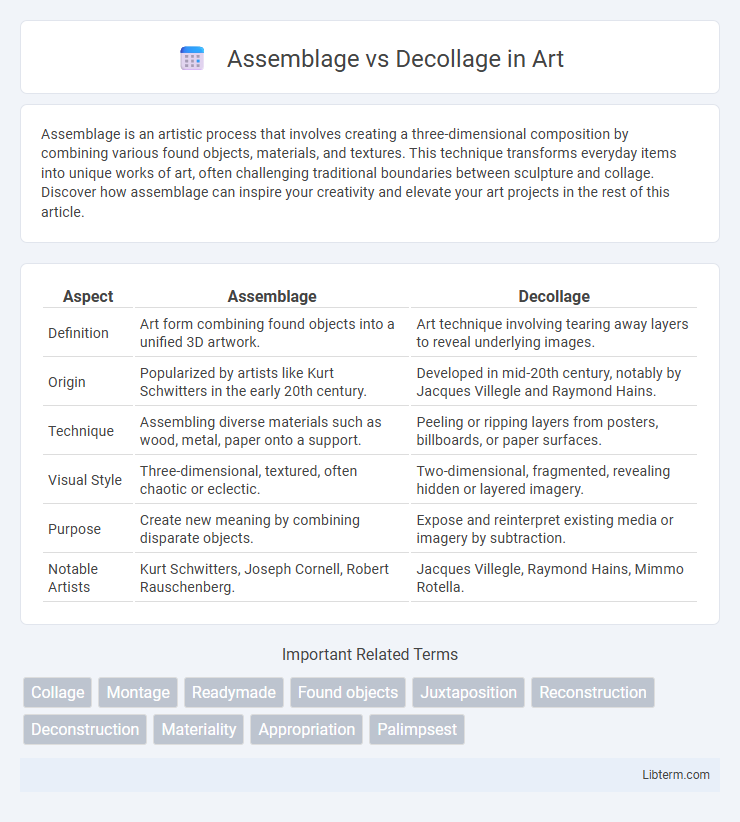Assemblage is an artistic process that involves creating a three-dimensional composition by combining various found objects, materials, and textures. This technique transforms everyday items into unique works of art, often challenging traditional boundaries between sculpture and collage. Discover how assemblage can inspire your creativity and elevate your art projects in the rest of this article.
Table of Comparison
| Aspect | Assemblage | Decollage |
|---|---|---|
| Definition | Art form combining found objects into a unified 3D artwork. | Art technique involving tearing away layers to reveal underlying images. |
| Origin | Popularized by artists like Kurt Schwitters in the early 20th century. | Developed in mid-20th century, notably by Jacques Villegle and Raymond Hains. |
| Technique | Assembling diverse materials such as wood, metal, paper onto a support. | Peeling or ripping layers from posters, billboards, or paper surfaces. |
| Visual Style | Three-dimensional, textured, often chaotic or eclectic. | Two-dimensional, fragmented, revealing hidden or layered imagery. |
| Purpose | Create new meaning by combining disparate objects. | Expose and reinterpret existing media or imagery by subtraction. |
| Notable Artists | Kurt Schwitters, Joseph Cornell, Robert Rauschenberg. | Jacques Villegle, Raymond Hains, Mimmo Rotella. |
Introduction to Assemblage and Decollage
Assemblage is an artistic technique that involves creating three-dimensional compositions by assembling disparate objects, emphasizing texture, volume, and spatial relationships. Decollage, in contrast, entails the removal or tearing away of layers from posters or materials to reveal underlying images, highlighting fragmentation and destruction as creative processes. Both methods challenge traditional art forms by transforming found materials into new visual narratives that engage viewers through distortion and reconstruction.
Defining Assemblage: Art from Found Objects
Assemblage is an art form that constructs three-dimensional works by combining found objects, often everyday materials, to create new meanings and narratives. This technique emphasizes the transformation of discarded items into cohesive, expressive compositions that challenge traditional art boundaries. Artists like Joseph Cornell and Louise Nevelson pioneered assemblage by juxtaposing diverse elements to evoke memory, history, and personal symbolism.
What is Decollage? Techniques and Origins
Decollage is an art technique that involves tearing away or removing layers of posters, paint, or other materials to reveal what lies beneath, creating a fragmented collage effect. Originating in the 20th century, particularly within the Nouveau Realisme movement led by artists like Mimmo Rotella and Jacques Villegle, decollage challenges traditional collage by emphasizing subtraction rather than addition. Techniques include ripping, cutting, and peeling layers from urban billboards or surfaces, highlighting the passage of time and urban decay.
Historical Evolution of Assemblage and Decollage
Assemblage originated in the early 20th century as an extension of collage, gaining prominence through artists like Pablo Picasso and Marcel Duchamp, who incorporated found objects to challenge traditional art boundaries. Decollage emerged in the mid-20th century, particularly within the Nouveau Realisme movement led by artists such as Francois Dufrene and Mimmo Rotella, who created art by tearing away layers of posters and advertisements to reveal fragmented imagery. Both techniques reflect evolving attitudes toward materiality and urban culture, with assemblage emphasizing construction and decollage emphasizing destruction and revelation.
Key Artists in Assemblage and Decollage
Assemblage, characterized by artists like Joseph Cornell and Louise Nevelson, involves creating three-dimensional compositions using found objects arranged in a cohesive artistic form. Decollage, exemplified by artists such as Mimmo Rotella and Raymond Hains, involves the technique of tearing away or removing pieces from posters or layers to reveal underlying images, emphasizing fragmentation and urban decay. These contrasting methods highlight differing approaches to collage art, with assemblage focusing on construction and sculptural depth, while decollage centers on destruction and layered visuals.
Materials and Methods: Comparing Artistic Processes
Assemblage involves creating art by assembling diverse materials such as wood, metal, fabric, and found objects into a cohesive three-dimensional composition. Decollage emphasizes subtractive techniques, where artists remove or cut away layers of posters, paper, or paint to reveal underlying imagery and textures. These differing methods showcase Assemblage's additive construction versus Decollage's layered deconstruction, highlighting contrasting material manipulation in contemporary art.
Assemblage vs Decollage: Core Differences
Assemblage combines various found objects into a cohesive three-dimensional artwork, emphasizing construction and synthesis, while decollage involves tearing away or deconstructing existing images or materials to reveal underlying layers, focusing on destruction and revelation. Assemblage highlights creativity through accumulation and integration of diverse elements, whereas decollage centers on fragmentation and the transformative impact of removal. The core difference lies in assemblage's additive approach versus decollage's subtractive method in visual expression.
Visual Impact: Style and Expression
Assemblage creates visual impact through the layering of diverse materials and objects that form a cohesive three-dimensional composition, emphasizing texture and depth to engage the viewer's senses. Decollage generates dramatic visual effects by revealing portions of underlying imagery, often through tearing or cutting, which conveys spontaneity and raw energy in its style. Both techniques express contrasting approaches to physicality and narrative: assemblage constructs meaning by accumulation, while decollage emphasizes fragmentation and the ephemeral nature of images.
Cultural and Artistic Influence
Assemblage and decollage profoundly shaped post-war art movements by challenging traditional aesthetics and embracing found objects and urban detritus, symbolizing cultural fragmentation and reconstruction. Assemblage assembles disparate elements into a cohesive whole, reflecting the complexity of modern identity, while decollage reveals underlying layers by tearing away surfaces, embodying cultural upheaval and memory. Both techniques influenced Pop Art and Nouveau Realisme, expanding artistic expression and critiquing consumerism and mass media through materiality and visual disruption.
Assemblage and Decollage in Contemporary Art
Assemblage in contemporary art involves creating three-dimensional compositions by combining found objects and materials, emphasizing texture and form to evoke new meanings. Decollage contrasts this by deconstructing existing images or posters, often through tearing or cutting, to reveal layered visuals and subvert original contexts. Both techniques challenge traditional aesthetics, with assemblage constructing narratives from fragments while decollage exposes underlying layers of visual culture.
Assemblage Infographic

 libterm.com
libterm.com